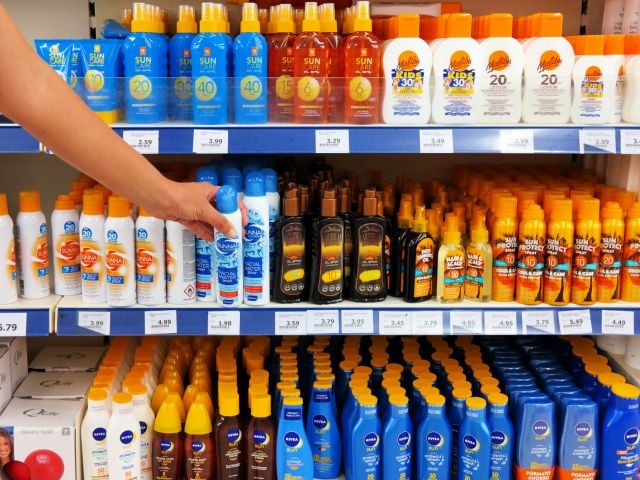
Many consumer product companies tout the environmental and health benefits of what they sell, but some of these claims fall short of the hype – a problem known as “greenwashing.”
Greenwashing is the persuasive deception or misleading details about a product that make it sound better for the environment than it actually is.
If you’ve bought cosmetics or other products with green-colored packaging or boasts about being “all natural” on the label, there’s a chance such packaging lured you in. Although many claims are valid, some product labels aren’t worth the paper they’re printed on.
Now more than ever that’s why consumers looking for solid information about what is and isn’t safe, turn to trusted, independent validators such as EWG and our searchable databases of personal care and cleaning products.
Greenwashing everyday products
Almost every category of consumer goods and industrial raw materials includes images, design or verbiage that conjure up visions of nature and the environment. They appeal to growing demand from consumers for more-sustainable products without harmful ingredients.
Greenwashing isn’t just a problem for shoppers of personal care products. It’s also an issue with cleaning products, not to mention other common household goods, such as cribs, mattresses, vacuum bags, even an “eco-conscious” toaster and food marketing.
Companies can make their product seem better for the environment than it actually is using vague, deceptive, trivial, confusing, unsupported, exaggerated or selectively truthful claims. They may rebrand entirely with a green color palette and tree images.
Most people are hesitant to accept such claims at face value – they want to evaluate products based on criteria from a trusted source, according to an EWG cosmetics survey.
Unclear and confusing claims
Part of the problem with greenwashing is that lofty statements about the environmental and health benefits of some products focus on what consumers are looking for, rather than being verifiable claims firmly grounded in the latest science.
Anyone can manufacture a product full of toxic chemicals, slap the image of a tree on it, and call it green and better for your health.
Marketing for these products uses descriptors such as natural, nontoxic, healthy or organic, even when they are not. Labels may say something is “free of” a particular toxic chemical, even if it contains that ingredient at very low levels.
Or products may exploit some popular phrases that could entice environmentally-conscious consumers, such as “reef safe,” based on ingredients they do or don’t contain.
Companies, and some third-party certifications, may define certain terms used on labels, such as “natural” or “non-toxic.” The Federal Trade Commission says it is illegal to make claims that are “unfair or deceptive.” But use of these terms isn’t closely regulated, so what’s considered unfair or deceptive may be unclear and confusing for consumers.
Decoding common statements
The FTC and the Food and Drug Administration share responsibility for oversight of environmental and health statements companies make about personal care products and cleaners. Here are some of the most common claims, according to the FTC:
Natural. This doesn’t always mean safe: Poison ivy is natural, but it’s best to avoid. The same is true for product labels claiming “all natural” ingredients – it’s easy to say this even if it applies to just 5 percent of the ingredients. But it’s a compelling claim, because who isn’t drawn to a product that claims to derive completely from nature?
Non-toxic. This vague claim implies a product and/or packaging poses no risk to people and the environment. But everything is potentially toxic – it can be dangerous to eat too many persimmons, for instance. A company must have “competent and reliable scientific evidence” that its product or package isn’t toxic, or must clearly and prominently qualify the claim.
Gentle or hypoallergenic. These claims imply that a product will present lower risk of irritation than others, so they’re more suitable for sensitive skin. But “gentle” is a relative term, and allergic reactions vary from person to person.
Green or eco- and planet-friendly. These labels imply a product that’s less harmful for the environment than others, such as one made with ingredients that don’t harm the natural surroundings when they enter the wastestream. Look at how the company defines its terms and study the evidence they offer.
Sustainable. Many consumers care not just about ingredients but also whether the packaging is recyclable, degradable or compostable. The FTC defines these terms, but consumer understanding of them may vary. Consumers are left on their own to figure out whether an entire product’s packaging is recyclable, or all but the cap, whether the product is entirely recyclable, or only a part of it.
Trivial and misleading claims. A company may claim its products are more planet friendly or healthy than its competitors’. That may technically be true while also distracting from the harmful impact of the product category itself on human health and environmental well-being.
Or a company can say a product is “conscious” without defining the word.
Why greenwashing is permitted
Uncertainty about marketing claims stems from far-from-perfect coordination among the oversight agencies involved.
The FDA and FTC ensure truthful marketing of personal care products and household cleaners, among other consumer goods. But because of limited oversight and enforcement capabilities, they often don’t do what’s needed to keep Americans safe.
By contrast, earlier this year the European Union enacted a law banning generic environmental claims and requiring that sustainability claims be backed by certification.
In addition to the FTC and FDA, the Environmental Protection Agency and the Consumer Product Safety Commission also share overlapping responsibilities for accurate consumer product labeling. But they often fall short.
The FDA focuses on claims about labeling, including supposed health claims. The FTC oversees advertising and promotions to ensure health-related products are “truthful, not misleading, and supported by science.” The FTC Green Guides give companies standards and definitions.
Some states are taking matters into their own hands. California enacted a law in 2017 requiring cleaners to disclose ingredients, with narrow exceptions. Another Golden State law banning false and misleading claims took effect at the beginning of the year. Other states have followed suit, Illinois and New York among them.
How to sidestep greenwashing
When you’re shopping for cosmetics or other personal care products, here are some simple tips that can help keep you from falling for greenwashing claims that might not be true:
- Look closely at labels. View marketing claims with skepticism – especially if a product falls into a category where ingredient transparency isn’t required. For instance, manufacturers of cleaning products don’t need to disclose their ingredients, except in California. Study the label – when there is one – starting with claims on the front of the product, which may well be better substantiated. Then look at the back label. Finally, check the product or company website.
- Check ingredients. For most people, scanning ingredients lists can be daunting. A product is more likely to be harmful the more ingredients it has, and the more complicated their names. Take a look at our list of the 12 most toxic cosmetics ingredients. And watch out for harmful substances in cleaning products, too. For both categories, steer clear of “parfum” and “fragrance.”
- Turn to trusted sources. You can consult EWG’s Skin Deep® free, searchable database of safer personal care products rated on their ingredient hazards. Some products in Skin Deep and our Guide to Healthy Cleaning bear the EWG Verified® mark. EWG Verified products must be free from ingredients on our list of chemicals of concern and provide full ingredient transparency – so rest assured it’s exactly what it says it is, backed by decades of chemical safety research.
- Use Healthy Living. For shopping on the go, download our Healthy Living app to gather information about potential purchases.
The FDA, FTC and other agencies must work together to protect shoppers from consumer product greenwashing. In the meantime, think twice about assuming the truth of product claims related to the environment or your health.



